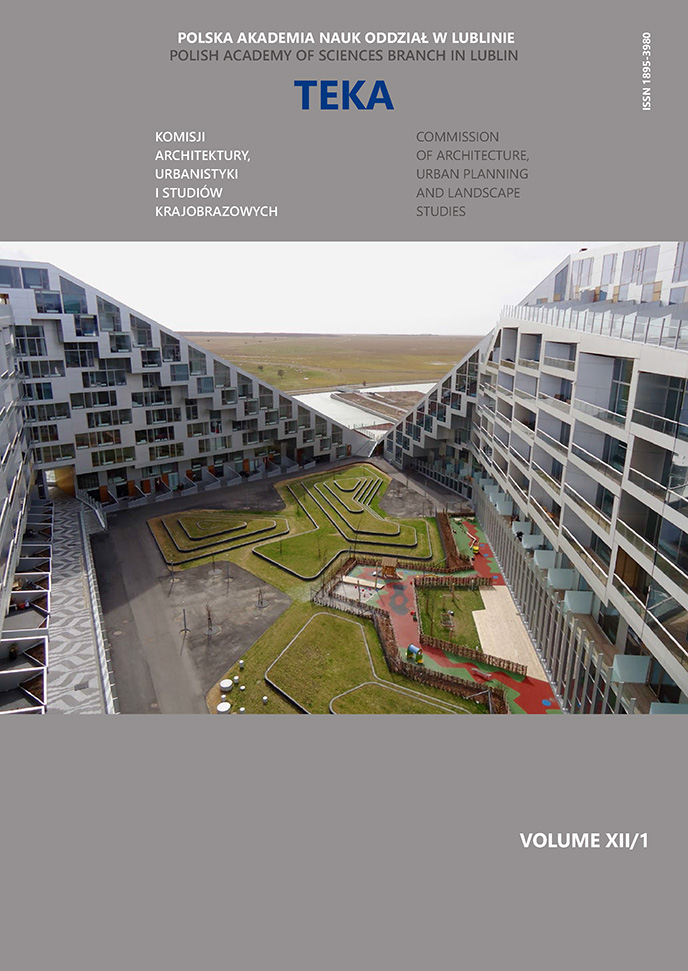Role of imagination in a creativity process and a threats of the modern world
Article Sidebar
Open full text
Issue Vol. 12 No. 1 (2016)
-
The impact of Unite d’Habitation on the formation of Superjednostka in Katowice
Joanna Kania7-15
-
Historic alleys of Podlasie region – Droblin, Leśna Podlaska commune
Wojciech Durlak, Margot Dudkiewicz, Mariusz Szmagara16-21
-
Disability vs spatial planning and landscaping – selected examples
Paweł Szumigała, Piotr Urbański22-28
-
Natural ventilation and thermal comfort in public buildings
Joanna Pieczara29-39
-
Issues of adapting design solutions to the needs of seniors and people with disabilities in teaching urban design
Marzena Joanna Siestrzewitowska40-48
-
Multi-criterion comparative analysis – tool for the functional quality assessment of flats
Part I. The base of conducted examinationsWalery Jezierski, Maciej Kłopotowski, Anna Gromadzka49-58 -
Complexity of city structure in reference to Barcelona
Wojciech Kocki, Bartłomiej Kwiatkowski59-64
-
Role of imagination in a creativity process and a threats of the modern world
Mariusz Dąbrowski, Agnieszka Chęć-Małyszek65-80
Archives
-
Vol. 16 No. 4
2020-12-30 11
-
Vol. 16 No. 3
2020-09-30 10
-
Vol. 16 No. 2
2020-06-30 11
-
Vol. 16 No. 1
2020-03-31 10
-
Vol. 14 No. 3
2018-10-28 14
-
Vol. 14 No. 2
2018-06-29 14
-
Vol. 14 No. 1
2018-03-30 13
-
Vol. 13 No. 4
2017-12-29 8
-
Vol. 13 No. 3
2017-09-29 9
-
Vol. 13 No. 2
2017-06-30 10
-
Vol. 13 No. 1
2017-03-31 10
-
Vol. 12 No. 4
2016-12-30 12
-
Vol. 12 No. 3
2016-09-30 10
-
Vol. 12 No. 2
2016-06-30 9
-
Vol. 12 No. 1
2016-03-31 8
-
Vol. 11 No. 4
2015-12-30 14
-
Vol. 11 No. 3
2015-09-30 7
-
Vol. 11 No. 2
2015-06-30 8
-
Vol. 11 No. 1
2015-03-31 11
Main Article Content
DOI
Authors
Abstract
In all areas of creative activities imagination is an essential element of life and man’s functioning. In many situations in our life it is an inherent element used in many cases more or less consciously. It allows you to create images that have no equivalents in any impressions presenting the basis for creativity and all human activity. Imagination is a natural extension of sight. It is a peculiar ability to form images, encouraging creative reflection and activities of young people. Nowadays a human being is constantly bombarded with an increasing numberof sounds and images, which “choke” the natural evolution of imagination. The fast technological progress, that we witness does not remain without influence on the development of creative thinking, it creates barriers that can restrain a human being.
Keywords:
References
Baudelaire Ch., Szkice krytyczne, Wrocław 1961, s. 93−96. DOI: https://doi.org/10.1002/jpln.19610930113
Berlyne E.D., Struktura i kierunek myślenia, Warszawa 1969
Bobra Por. M. Sangs of Innocence and Experience, (w) Romantic Imaginacjon, London 1961, s. 25−31.
Bronowski J., Źródła wiedzy i wyobraźni, Warszawa 1984, s. 24−31.
Chmielewski Por. P., Geneza fantazji, Warszawa 1873, s. 47
Dobrołowicz W., Psychologia o myśleniu intuicyjnym, „Studia Filozoficzne”, 1981, ur U, ss. 105−121
Dobrołowicz W., Psychika i bariery, Warszawa 1993.
Dobrołowicz W., Antykreatywność – bariery psychiczne i psychospołeczne,w: Twórczość – wy-zwanie XXI wieku, E. Dąbrowska, A. Niedźwiecka (oprac.), Kraków 2003.
Dobrołowicz W., O myśleniu intuicyjnym, „Studia Filozoficzne”, 1981, nr U, ss. 105−121.
Gloksina W., Uwarunkowania psychicznego rozwoju dziecka, Warszawa 1988.
Grzywacz M. – Kaczyńska, Psychologia dla każdego, Warszawa, s. 91
Górniewicz J., Wstęp do pedagogicznej analizy problematyki wyobraźni, Toruń 1991, s. 22−26
Hornowski B., Rozwój inteligencji i uzdolnień specjalnych, Warszawa 1978, s. 47,102.
Jacobs N.J., Maimon’s Theory of the Imagination, (w) Studies in Philosophy Jerusalem 1960, s. 250−257.
Kant J., Krytyka władzy sądzenia, Warszawa 1986, s. 124−129.
Klimasiński K., Kształcenie wyobraźni konstrukcyjnej, Warszawa 1978, s. 10.
Kondas O., Psychologia kliniczna, Warszawa 1984, s. 183−183
Łukaszewski W., Szanse rozwoju osobowości, Warszawa 1984, s. 254.
Łuszczak M., Możliwości kształtowania wyobraźni twórczej studentów, Cieszyn 1997, s. 47, 51.
Łukasiewski W., Szanse rozwoju osobowości. Warszawa 1983, s. 253−254.
Morawski Por. S., Poglądy Józefa Kremera na sztukę, (w:) Studia historii myśli estetycznej XVIII i XIX w., s. 260.
Nałczadżjan A., Intuicja a odkrycia naukowe, Państwowy Instytut Naukowy, 1979 Warszawa, s. 46−47.
Nowicki T.W., Zarys psychologii, Warszawa 1979, s. 92.
Popek S., R. Tarasuk, pod red., U podstaw edukacji plastycznej, Lublin 2000, s. 86.
Popek S. red., Twórczość w procesie rozwoju dzieci i młodzieży, Lublin 1982, s. 7.
Popek S. red., Twórczość artystyczna wychowania dzieci i młodzieży, Warszawa 1985 s. 37.
Popek S., R. Tarasiu red., U podstaw edukacji plastycznej, Lublin 2000 s. 86−87
Przetacznikowa M., G. M. Jarża, Psychologia…op.cit.,s. 102
Ribot T., O wyobraźni twórczej, Warszawa 1901, s. 5−6, 112
Rozet J., Psychologia fantazji, Warszawa 1982, s. 20.
Ribot Th., O wyobraźni twórczej Warszawa 1901, s. 9,10, 112
Rubinsztejn S.L., Podstawy psychologii ogólnej. Warszawa 1962, s. 432−442, 438
Rukin J., O wyobraźni (w) Sztuka – Społeczeństwo – Wychowanie, Wrocław 1977, s. 49−50, 63
Sławska K., Myśl w działaniu – psychologia myślenia, Warszawa 1971, s. 171−172
Singer J.L., Marzenia dzienne, Warszawa, 1980, s. 152−153
Szuman S., O budzeniu i pogłębianiu wrażliwości młodzieży na sztukę, Nowa Szkoła” 1961 nr 5.
Suchodolski B., Wychowanie i strategia życia, Warszawa 1983, s. 183.
Shelley P. B., Obrona poezji, (w) Manifest romantyzmu 1790−1830 Op.cit.,s. 101.
Szewczuk W. (red.), Słownik psychologiczny, Warszawa 1979, s. 328 (hasło 1,2 i 4 opracował E. Szewczuk, W. Szewczuk).
Szczepański J., Sprawy ludzkie, Warszaw 1984, s. 147−149.
Troskoliński A.T., O twórczości. Piśmiennictwo naukowo-techniczne, Warszawa 1982, s. 41,48
Trojanowska – Kaczmarska A., Dziecko i twórczość, Wrocław – Warszawa – Kraków – Gdańsk 1971
Tyszkowa M., Baśń w życiu i rozwoju dziecka, „Wychowanie w Przedszkolu”, 1974, nr 4, s. 199.
Witwicki W., Psychologia, t.I, Warszawa 1962, s. 336−340, 379
Vico G., Nauka nowa, Warszaw 1966, s. 475−476.
Young E., Propozycje dotyczące oryginalnej twórczości, (w:) Teoria ba dań literackich za gra-nicą Antologia, t. 1, (Wybór i opracowanie S.Skwarczyńska), Kraków 1965, s. 165.
Zakski Z. L., Rola wyobraźni w twórczości naukowej, Hanower 1946, s. 9−10
https://pl.wikipedia.org/wiki/Sztuka_prehistoryczna
Article Details
Abstract views: 149


